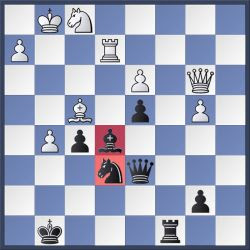Mista,Aleksander (2561) - Bojkov,Dejan (2541) [A24]
1st League CS 2011 Kraljevo (5.3), 20.09.2011
[Dejan ,Bojkov]
1.Nf3 Nf6 2.c4 A small surprise. Mista played this move more often in the Serbian League, but he usually choses the open games. 2...g6 3.g3 Bg7 4.Bg2 0–0 5.0–0 d6 6.Nc3 e5 7.d3 Nbd7 A flexible continuation. [The main move is: 7...Nc6] 8.Rb1 Re8 9.Nd2 In case of: [9.b4 Black can react with: 9...e4 10.Nxe4 Nxe4 11.dxe4 Rxe4 12.Qd3 (12.Nd2 Re8 13.Bb2 Nf6 14.e4 1/2 (14) Pfleger,H (2490)-Hausner,I (2435) Germany 1988) 12...Qe7] 9...a5 10.a3 h5N

This move appeared to be an over-the-board novelty. Larsen would love to see that. First a7–a5, then h7–h5. However, while the first move was designed to make the rook work from its initial position, the latter intends to start the real play on "my own flank". [10...Nh5?! is somewhat slow, and the advance of the f pawn will weaken the light squares in the center.] 11.b4 axb4 12.axb4 h4 13.Nde4 [Probably better was to finish the development of the pieces- 13.Bb2]

13...Nh7! Now f7–f5 is coming with tempo, and the knights are obstructing each other. The Polish GM tries to support them tactically. 14.Qd2?! Ndf8 [14...f5 White's idea is dicovered in the line: 15.Ng5 Bh6? 16.Bd5+ Kg7 (16...Kh8 17.Nf7+) 17.Ne6++–] 15.c5 Be6?! Misses a small detail. [I somehow missed that in the line: 15...d5 16.Nxd5 Qxd5 17.Nf6+ Nxf6 18.Bxd5 Nxd5 Black takes three (and not two!) pieces for the queen. Despite what the computer says, I would love to have the pieces here.; 15...h3!? was another decent option. 16.Bh1 Be6 17.cxd6 cxd6] 16.cxd6 cxd6 17.gxh4! This is it, White can take the pawn, and make use of the g5 square. 17...d5 [17...Qxh4 18.Nxd6 Bh3 19.Bxh3 Qxh3 20.Nxe8 Qg4+ 21.Kh1+–; 17...f5? 18.Ng5] 18.Ng5

White returns the favour. He could have achieved some edge with: [18.Nc5 d4 19.Nb5! Not: (19.N3e4 Bd5; nor: 19.Nxb7? dxc3 20.Nxd8 cxd2 21.Nxe6 dxc1Q 22.Rfxc1 Nxe6 23.Bxa8 Rxa8 is much better for Black) 19...Qb6 20.Na3!] 18...d4 19.Nce4 [19.Nxe6? dxc3] 19...Bd5 Now the centralized position of the black pieces compensates with interest for the lost pawn. 20.f4 [20.h5 gxh5] 20...f5 21.Ng3 [21.Nc5 Bxg2 22.Kxg2 exf4 23.Qxf4 Rxe2+ is just bad for White.] 21...Bxg2 22.Kxg2 Qd5+ 23.Kg1 Nxg5! 24.hxg5 Ne6 25.fxe5 [Or: 25.Qe1 Ra2!? (25...Nxf4 26.Bxf4 exf4 27.Rxf4 Be5 with powerful centralization.) ] 25...Bxe5 The centralized position of the black pieces allows him to play on both flanks. At the moment, a decisive attack is on the agenda. 26.Qd1 [26.Qe1 Ra2] 26...Ra2 Prevents Qd1–b3. However, some consistency would not harm: [26...Kg7 27.Qb3 (27.Bb2 Nxg5) 27...Qd6 28.Rf3 Rh8 29.b5 Rh4 and Black's advantage is overwhelming.] 27.Rf2 [27.Qb3 Qxb3 28.Rxb3 Bxg3 29.hxg3 Rxe2 takes back the pawn with comfort.] 27...Rc8 28.Nf1 The culmination of the battle. I had to decide which rook to place on c2. The logic showed that it should be the less active one, but... 28...Rac2? One wrong move and a good game is thrown away. After the correct: [28...Rcc2! The game might have finished with a beautiful attack: 29.h4 would not help neither, as White has practially nothing to move. (29.e4 dxe3! 30.Rxc2 White is also getting mated after: (30.Nxe3 Rxf2 31.Nxd5 Rg2+ 32.Kf1 Rxh2 33.Kg1 Rag2+ 34.Kf1 Rf2+ 35.Kg1 Bd4 36.Be3 Bxe3 37.Nxe3 Nxg5) 30...Nxg5!

and despite the extra move (and rook!) White cannot prevent mate! 31.Ng3 (31.Nxe3 Nh3+ 32.Kf1 Qh1+ 33.Ke2 Qxh2+ 34.Kf3 (34.Ke1 Bc3+ 35.Kf1 Qf2+ 36.Rxf2 Rxf2#) 34...Qf2+ 35.Rxf2 Rxf2#) 31...Nh3+ 32.Kf1 Rxc2 33.Qxc2 Qf3+ 34.Ke1 Bxg3+ 35.hxg3 Qxg3+ 36.Kd1 Qg1+ 37.Ke2 Qf2+ 38.Kd1 Qf1#) 29...Qc6 There is a more prosaic way to end the game- (29...Qd6 30.Ra1 Rxa1 31.Qxc2 Qc6 32.Qxc6 bxc6 33.Bd2 Bg3 34.Rf3 Bxh4 35.Rh3 Be1 36.Bxe1 Rxe1–+) 30.Qe1 Bf4! 31.Bxf4 Nxf4 32.Rxf4 Rxe2–+] 29.e4 Qa2 30.Rb2! The story as old as the chess game. I saw that one only after I have played Ra2–c2. My hopes were pinned with: [30.Rxc2 Rxc2 31.Bd2 fxe4 32.dxe4 d3 with almost decisive advantage.] 30...Rxb2?! My frustration was that bad, that I did not put up strong resistance: [30...Rxc1 31.Qxc1 Rxc1 32.Rxa2 Nxg5 33.Kg2 fxe4 (33...Ne6! 34.exf5 Nf4+ 35.Kf3 (35.Rxf4 Bxf4 36.fxg6 Kg7) 35...Nxd3 36.Rfd2 Nxb4 37.Rab2 Rxf1+ 38.Kg2 Rxf5 39.Rxb4=) 34.Ra5 Nf3 35.dxe4 Ne1+ 36.Kg1 Bc7 37.Rc5 Rc3] 31.Rxb2 Qa1 32.Qb3! [Much better than: 32.Rc2 Rxc2 33.Qxc2 Qc3!] 32...Qa6 [32...Rxc1 33.Qxe6+ Kh7 34.Rf2+–] 33.exf5 gxf5 34.Re2 Qd6 And it is White's turn to be flashy, which he does not miss: 35.Bf4!

After this game the Polish GM achieved three move wins to start with the fabulous 8/8![35.Bf4 Bxf4 36.Rxe6 Rc3 37.Re8+ Kg7 38.Qg8#] 1–0
No comments:
Post a Comment